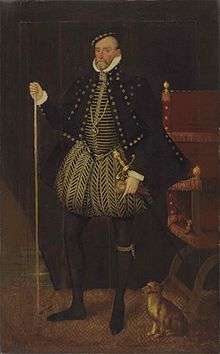William Herbert, 1st Earl of Pembroke (died 1570)
William Herbert, 1st Earl of Pembroke, 1st Baron Herbert of Cardiff KG (c. 1501 – 17 March 1570) was a Tudor period nobleman, politician, and courtier.
The Earl of Pembroke KG | |
|---|---|
 The young William Herbert wearing a Greenwich armour. Portrait at the National Museum in Cardiff. | |
| Born | c. 1501 |
| Died | 17 March 1570 |
| Title | 1st Earl of Pembroke |
| Spouse(s) | Anne Parr, Anne Talbot |
| Children | 3 (including Henry Herbert, 2nd Earl of Pembroke) |
| Parent(s) | Sir Richard Herbert Margaret Cradock |


Herbert was the son of Sir Richard Herbert and Margaret Cradock.[1] His father was an illegitimate son of William Herbert, 1st Earl of Pembroke of the eighth creation (1468) by his mistress, Maud, daughter of Adam ap Howell Graunt.[1]
Early life
William Herbert's early life was distinguished by intense ambition coupled with an equally fierce temper and hot-headed nature. Described by John Aubrey as a "mad fighting fellow," the young Herbert began his career as a gentleman servant to the earl of Worcester. However, when a mercer called Vaughan was killed by Herbert, after an affray between some Welshmen and the watchmen for unknown reasons in Bristol, he fled to France.
Upon arrival, he immediately joined the service of King Francis I as a soldier, earning a reputation for courage and great skill on the battlefield. "In a short time he became eminent, and was favoured by the king, who afterwards recommended him to Henry VIII of England, who much valued him, and heaped favours and honours upon him." For his service to King Henry, Herbert was granted the estates of Wilton, Remesbury, and Cardiff Castle, and his position as a man of means was secured.
Herbert's first wife, Anne Parr, was sister of Queen consort Catherine Parr, sixth wife to King Henry VIII. He rose with the Parrs after his sister-in-law's marriage and was knighted in 1544. He had been granted Wilton Abbey and other land by Henry VIII by 1544. He pulled down the abbey, and built the first Wilton House in the 1540s.
Earldom

Herbert was a Guardian of the young King Edward VI after the death of Henry VIII in 1547. As an executor of Henry's will and the recipient of valuable grants of land, Herbert was a prominent and powerful person during Edward's reign, with both the protector Edward Seymour, 1st Duke of Somerset and his rival, John Dudley, angling for his support. He threw in his lot with Dudley, and after Somerset's fall obtained some of his lands in Wiltshire.[2] He was made a Knight of the Garter in 1549, and created Baron Herbert of Cardiff on 10 October 1551, and 1st Earl of Pembroke (of the tenth creation) the following day, by Edward VI.
After the death of Edward VI, Herbert initially supported Lady Jane Grey's claim to the throne. Herbert arranged the marriage of his eldest son and heir, Henry, to Jane's sister, Lady Catherine Grey, at Durham House on 25 May 1553,[3] the same day as her sister Jane was married to Guilford Dudley. The third couple married that day was the Duke of Northumberland's youngest daughter, Katherine, to Henry Hastings, 3rd Earl of Huntingdon.[3] When it became clear that Lady Mary Tudor would take the throne as Mary I, he cast his daughter-in-law, Catherine, out of his house and had the marriage annulled. Lady Catherine's father and sister, Jane, were both executed for high treason in February 1554 by the orders of Queen Mary I. Herbert managed to distance himself from the Grey family after their fall and obtained the new queen's favour by crushing Thomas Wyatt's rebellion. In 1557 the English army under the Earl of Pembroke did not arrive in time for the battle of St Quentin, but played a significant role in the capture of the city that followed. Pembroke was Mary's most effective commander at the war with France.
Mary sometimes suspected Pembroke's loyalty, but he was employed as governor of Calais, as president of Wales and in other ways. He was also to some extent in the confidence of Philip II of Spain. The earl retained his place at court under Elizabeth I until 1569, when he was suspected of favouring the projected marriage between Mary, Queen of Scots, and the duke of Norfolk.[2]
According to John Aubrey's very colourful Brief Life, he could "neither read nor write" but "had a stamp for his name." Aubrey says: "He was of good naturall parts, but very colericque. In Queen Mary's time, upon the return of the Catholique religion, the nunnes came again to Wilton Abbey; and this William, Earl of Pembroke, came to the gate which lookes towards the court by the street, but now is walled up, with his cappe in his hand, and fell upon his knees to the Lady Abbess and nunnes, crying peccavi. Upon Queen Mary's death, the Earl came to Wilton (like a tigre) and turned them out crying, "Out, ye jades! to worke, to worke—ye jades, goe spinne!"
Herbert had a secretary 'Robert Streynsham', who lived in the Parsonage in Ospringe (near Faversham in Kent).[4]
Herbert is reported to have had a close bond with his pet dog. Aubrey writes that he "had a little cur-dog which loved him, and the earl loved the dog. When the earl died the dog would not go from his master's dead body, but pined away, and died under the hearse." Herbert's dog can be seen in the portrait at left.
Marriages and issue
Herbert married twice:
- Firstly to Anne Parr (died 20 February 1552), the younger sister of Queen Catherine Parr, 6th and last wife of King Henry VIII, by whom he had progeny:
- Henry Herbert, 2nd Earl of Pembroke (c. 1539 – 1601), eldest son and heir, who in 1553 married Lady Catherine Grey.[3] The marriage was annulled in 1554 and he married secondly Catherine Talbot, a daughter of George Talbot, 6th Earl of Shrewsbury. His third wife was Mary Sidney, a granddaughter of John Dudley, 1st Duke of Northumberland, by whom he had issue, including William Herbert, 3rd Earl of Pembroke and Philip Herbert, 4th Earl of Pembroke.
- Sir Edward Herbert (1547–1595), who married Mary Stanley, a daughter of Sir Thomas Stanley, Under-Treasurer of the Mint, by whom he had issue including William Herbert, 1st Baron Powis.[5]
- Lady Anne Herbert (1550–1592), who in February 1562 married Francis, Lord Talbot, eldest son and heir apparent of George Talbot, 6th Earl of Shrewsbury, whom he predeceased. There is no known issue from this marriage.[6]
- Secondly he married Anne Talbot, a daughter of George Talbot, 4th Earl of Shrewsbury, and widow of Peter Compton. There was no issue from this marriage.
Death
William died on 17 March 1570, in Hampton Court. He was buried on 18 April 1570 in Old St Paul's Cathedral, where his first wife, Anne (Parr) Herbert, had been buried. His grave and monument were destroyed in the Great Fire of London in 1666. A modern monument in the crypt lists him as one of the important graves lost.
References
Citations
- John Bernard Burke. A genealogical and heraldic dictionary of the peerage and baronetage of the British Empire, 14th Edition, Colburn, 1852. pg 783. Google eBook
-

- Eric Ives. Lady Jane Grey: A Tudor Mystery, John Wiley & Sons, Sep 19, 2011. Google eBook Preview
- Hasted, Edward (1798). "Parishes". The History and Topographical Survey of the County of Kent. Institute of Historical Research. 6: 499–531. Retrieved 17 March 2014.
- George Edward Cokayne, The Complete Peerage of England, Scotland, Ireland, Great Britain, and the United Kingdom, Vol. X, p. 643.
- Lee, Sidney, ed. (1891). . Dictionary of National Biography. 26. London: Smith, Elder & Co. pp. 220–223.
Bibliography
- G. E. Cokayne, Complete Peerage, 1910–1959
- Doyle, James William Edmund (1886). The Official Baronage of England: showing the succession, dignities, and offices of every peer from 1066 to 1885, Vol. III. London: Longmans, Green & Co. Retrieved 25 January 2007.
External links
| Wikimedia Commons has media related to William Herbert, 1st Earl of Pembroke (died 1570). |
| Honorary titles | ||
|---|---|---|
| Preceded by Unknown |
Custos Rotulorum of Glamorgan bef. 1544–1570 |
Succeeded by The Earl of Pembroke |
| Vacant Title last held by The Earl of Bedford |
Lord Lieutenant of Somerset 1559–1570 |
Vacant Title next held by The Earl of Pembroke |
| Preceded by New office |
Lord Lieutenant of Wiltshire 1551–1570 |
Succeeded by The Earl of Pembroke |
| Political offices | ||
| Preceded by Anthony Browne |
Master of the Horse 1548–1552 |
Succeeded by The Earl of Warwick |
| Preceded by The Earl of Arundel |
Lord Steward 1568–1570 |
Succeeded by The Earl of Leicester |
| Preceded by The Earl of Warwick |
Lord President of Wales and the Marches 1550–1553 |
Succeeded by Nicholas Heath |
| Preceded by Nicholas Heath |
Lord President of Wales and the Marches 1555–1558 |
Succeeded by Gilbert Bourne |
| Peerage of England | ||
| New title Title granted by Edward VI of England |
Baron Herbert of Cardiff 1551–1570 |
Succeeded by Henry Herbert |
| Earl of Pembroke 1551–1570 | ||